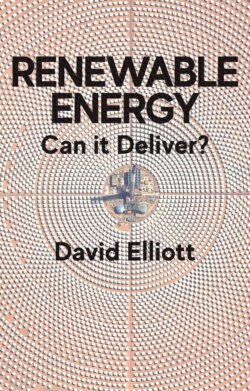Читать книгу Renewable Energy - David Elliott - Страница 20
Renewable balancing
ОглавлениеThat brings us to grid balancing and system integration, an area that is expanding in importance as the use of variable-output renewables increases. There will be times when there are local or regional lulls in energy available from the wind and the sun and, although some of the other renewable sources are not variable, there will be a need at times to provide balancing grid power (Elliott 2016).
One view sometime expressed by opponents of renewables is that each renewable energy project will have to be backed up 100% by conventional capacity. A moment’s thought should indicate that this is not the case. All power plants, of whatever type, can have downtimes, and we do not insist that each has its own individual backup. Instead, it is the power system as a whole, including all the other power plants, that provides backup, and it is the same for renewables. They may however need backup inputs more often than conventional plants.
Initially, with relatively low levels of renewable input, much of this extra balancing input can be provided by the remaining conventional plants, for example gas turbines, so we will not need new capacity – it already exists. It is the main way in which supply and demand variations are balanced on the grid. With variable renewables on the grid, the gas plants have to ramp up and down to full power a few times more. Some of that capacity can be gradually changed over to using non-fossil green gas so as to avoid emissions but, as renewables expand, extra balancing capacity may also be needed.
A simple view is that energy storage will solve everything, especially as it is getting cheaper. Sadly, it is more complex than that (Elliott 2017a). Batteries are getting cheaper, but they have low storage capacities and are best used to store electricity for a short time, a few hours or days at most. They can also be used to deal with short-term voltage and frequency perturbations on the grid, but for longer-term variations, and long lulls in power availability, you need large higher-capacity bulk-storage systems. Pumped hydro plants can perhaps cope for a few days, if they have large reservoirs. For longer than that, you need something extra.
Options for longer-term bulk storage include compressed air and hydrogen gas, stored in vast underground salt caverns. The hydrogen can be made by the electrolysis of water, using surplus output from wind and PV plants, converted back to electricity when needed in a fuel cell or gas turbine. Similarly, spare renewable power can be used to compress air for later use in a turbine.
An entirely different balancing approach is to convert excess renewable output into heat and store that. It is much easier to store heat than to store electricity. However, it is hard to convert low-grade heat back to electricity. That is where combined heat and power (CHP) becomes useful. CHP plants can use either fossil gas or biomass/biogas as a fuel to generate electric power, and they recycle some of the waste heat produced in that process, so they have high overall energy-conversion efficiency. Crucially, the ratio of the heat to power outputs can vary depending on demand, so as to help with balancing. If there is too much green power on the grid, the CHP plant can produce more heat, less power. If heat demand is also low, the heat can be stored. If there is not enough green power on the grid, the CHP plant can increase its electric power output and reduce its heat output, and if demand for heat is also high, the stored heat can be used. Solar heat can also be fed into the stores and so can heat produced from surplus wind and PV electricity and from geothermal sources, all of this heat eventually feeding into local district heating networks.
As can be seen, the problem of renewable variability can, in fact, be turned into at least a partial solution. With a large renewable capacity on the grid, sized so as to meet most demand most of the time, there will at times be significant surplus electricity output, which can be stored and used, directly or indirectly, via the systems described above to meet lulls in renewable availability at other times. Electricity top-ups can also sometimes be obtained from overseas, using long-distance ‘supergrid’ links, so that local shortfalls can be balanced, making use of the likelihood that, in widely separated areas (with different weather conditions and time zones), demand and supply patterns will often vary out of phase. For example, local wind surpluses at one time can be traded with power from wind surpluses elsewhere at other times, as wind fronts move across the globe. The location and timing of peak solar input also shifts around the world as the earth rotates. Supergrids would also give access to large hydro pumped-storage reservoirs for those without them and possibly also to renewable sources far off, including large solar arrays in desert areas (Fraunhofer 2016).
This new supply and storage system would be complemented with a new demand-side management system, able to shift demand peaks to times when more power was available, for example by variable pricing so that power costs more at peak times. Optimizing it all will be hard, but as balancing technology develops it should be possible to move towards a balanced sustainable energy system at reasonable cost (see Box 2.1).
